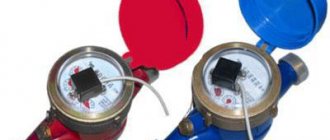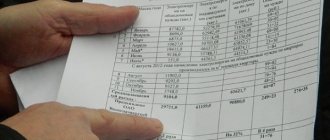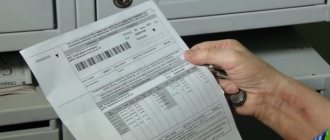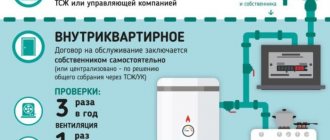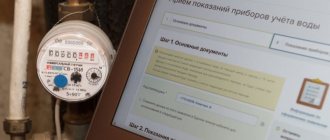Home / DHW
Back
Published: 12/09/2019
Reading time: 3 min
1
4949
Various abbreviations are written on receipts for housing and communal services. Some residents of apartment buildings located on the territory of the Russian Federation are interested in the question of what is cold water supply for hot water supply in the receipt.
Being able to decipher the abbreviations indicated in the payment document is necessary to control the correctness of charges.
- 1 What do cold water and hot water mean?
- 2 How the amount of water is calculated
- 3 Components of the cost of hot water supply
- 4 Legislative acts regulating the calculation
How to understand a rent receipt
Few people read their bills meticulously. Typically, residents pay attention only to their name and the amount to be paid. However, detailed knowledge on this issue will allow you to identify errors when calculating payments. Usually, when reading a document, abbreviations cause difficulties. It is not always possible to find a current account number. Other problems may arise.
To avoid all of the above, it is recommended to study a sample payment slip. What items should be on the housing and communal services receipt are established by law. The form of the document is also standard.
Explanation of the abbreviation DHW in the receipt
This is how hot water supply is indicated. However, the payment is not so much for water, but rather for heating it. This is exactly what thermal energy means on the receipt.
A house may not always be equipped with a centralized heating or hot water supply system. If a water heater is installed in the apartment, you will not have to pay for hot water. The source is important. Thermal energy for hot water supply is what comes from outside: from an autonomous boiler house near the house, from district or city networks.
Cost calculation
When calculating the cost of one cubic meter, the costs spent by the resource supplier for the following needs are taken into account:
- electricity payments;
- purchases of cleaning materials and components;
- research of water quality characteristics in laboratory conditions;
- payroll fund for the involved personnel and tax deductions;
- rental of equipment and other property;
- maintenance and repair of water pipeline networks, treatment facilities and other infrastructure facilities;
- carrying out environmental activities, document flow, etc.
We recommend: Unauthorized connection to the power grid
All positions are calculated based on the standards established by law.
In the presence and absence of individual metering devices
Tariffs for consumers with and without installed meters are the same. The difference lies in the counting system. Owners with registered metering devices pay according to their readings, for the amount of resources actually used. It is determined how much water the consumer consumed during the month, then the result is multiplied by the established price.
Additionally, expenses for general house needs are payable, calculated based on the difference in the readings of individual and household metering devices.
For consumers who do not use meters, payment is made according to approved standards, taking into account the monthly volume of water based on one resident registered in the apartment.
To encourage citizens to install meters, increasing coefficients are applied, legally limited to 1.5. Therefore, the amount to be paid, calculated according to the standards, will always be higher than the actually spent resources determined by the meter.

Features of DHW tariffication
Unlike cold water, the tariff for hot water supply consists of two parts:
- payment of the cost of cold water;
- the cost of heating it to the established temperature conditions ranging from 50 to 65 degrees above zero.
We recommend: How much electricity does an air conditioner consume?

Many utilities similarly divide the amount of payment for hot water in the submitted invoices in two, separately highlighting hot water and the cost of heating cold water.
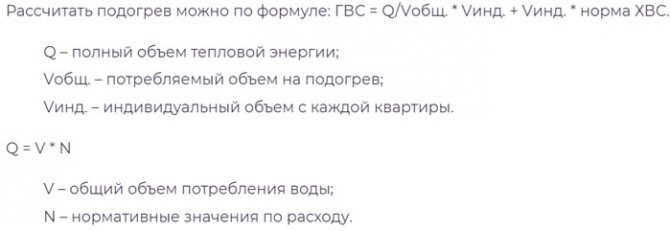
This methodology is recommended by state legislative norms and allows you to reflect in detail the distribution of costs for the provision of these services. Considering that cold water is supplied by the water utility, and its heating is carried out by another organization, costs must also be divided for subsequent transfer to suppliers.
Resources provided must be paid for appropriately. But if suppliers do not fulfill their obligations with the required level of quality, the consumer has the right to defend his own interests in court, attaching documentary evidence of the legitimacy of the claims made.
Legislative regulation of the issue

The last important change in this area was the introduction of a two-tier tariff in 2013. It was since then that people began to pay for hot water supply both for cold water and its heating component. This regulatory act is Government Decree No. 406 of May 13, 2013. The document is constantly changing. The latest amendments were adopted in October 2019. Based on the resolution, a thermal energy component for water heating appeared in receipts. This made the payment more transparent.
How to keep track of water consumption?
If you have installed a new meter, then you do not need to calculate the water consumption for the month, since it will display the readings in the first five cells (cubic meters). If the water meter is not new, then the latest data should be subtracted from the current indicators.
Expert opinion
Golubev Denis Petrovich
Lawyer with 7 years of experience. Specialization: civil law. Author of dozens of articles in the media
When you transfer data to the company, the cold and hot water readings need to be added up, and the hot water readings should be noted as water heating in cubic meters. Payment for sewerage is carried out in full volume of cubic meters of cold and hot water supply.
An example of taking readings from a meter
First, we determine which water the meter is connected to. Look at the color of its body or rim. Blue is cold water, and red is hot. If the meters have the same parameters, then open any water tap and see which device will rotate. Then we will fill out the receipt:
- We indicate your full name in the appropriate column.
- We record the date the readings were taken from the device.
- We record current water consumption indicators.
You can fill out the receipt using this link.
For example, on the cold water meter on the reporting date there were the following numbers 00078634, where the last three are liters. We need to enter the first five 00079 in the receipt (we round the last cell). In a month, our readings will be different: 00085213. Enter 00085 in the receipt.
This is important to know: The procedure for recognizing a house as unsafe
To calculate cold water, we need to indicate the difference between the current readings and the previous ones: 00085-00079=6 cubic meters. To calculate the final cost of the service, let’s take the approximate price for one cube - 38.06 rubles. We multiply the price by 6 cubic meters = 228.36 rubles per month.
Monthly water consumption is calculated automatically; you only need to rewrite the current readings. If you have two risers in your apartment: one hot and the other cold, then each meter transmits information about consumption.
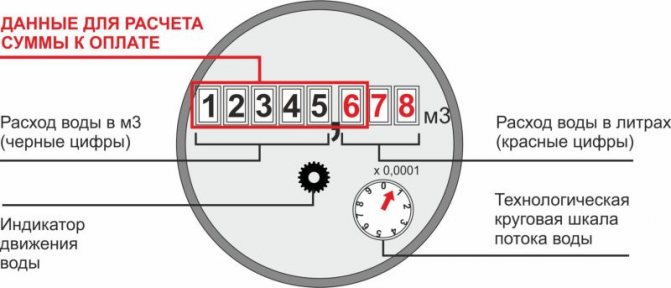
Water meter with electronic dial. How to take readings?
This water supply meter displays two parameters:
- Water consumption in liters.
- Water heating in cubic meters.
The peculiarity of this meter is that it detects hot water with a temperature below 40 degrees as cold. It is important to take both readings.
How to use the device?
There are two markers on the electronic scoreboard:
- The line number is indicated by the right marker.
- Column number is left.
V1 is the total volume of water that passed through the turbine.
V2 - indicators when connecting the device.
V1^ - hot water consumption (above 40 degrees).
T is the water temperature.
To switch the first marker, you need to make a long press on the counter. To switch the second marker, make a short press.
The numbers displayed in the third line show the amount of water spent during the reporting period. The checksum will be shown below. To take readings, you need to switch markers.
Classification of heat supply systems

The organization of hot water supply and heating is an important issue in public utilities. This industry is being actively researched by scientists. As a result, a lot of classifications are born.
- Systems are divided into intra-house, district, city and inter-regional.
- When determining what the hot water coolant is in the receipt, experts can subdivide it depending on the type of fuel: electricity or gas.
- Systems can be autonomous or centralized.
- Divided into single-pipe or multi-pipe.
However, it is primarily important for consumers to distinguish between open and closed systems. Let's see what the difference is.
Thermal energy component
You only need to pay for hot water if the supply system is open. If there is a water heater in the house, residents consume more gas. Consequently, they receive payment specifically for this resource.
Thermal energy for DHW needs is calculated using a formula taking into account the following factors:
- current tariff;
- consumption of resources for heating water;
- heat loss coefficient.
That is, consumers themselves, not suppliers, pay for the loss of heat that inevitably occurs during the passage of boiling water through pipes.
This is what the component for thermal energy in DHW is. This is compensation for water heating, which is carried out by utilities.
How to check the meter?
Verification is done in two ways:
- With the removal of the device.
- Using a portable testing unit (stationary).
This is important to know: Calculate sick leave: online calculator
A specialist from the organization comes to the consumer’s home with a controller that needs to be put on the faucet. The verification report must be certified using a special mark or stamp from an authorized organization. If the verification takes place at home, then the seal must be preserved, and all information must be entered into the registration certificate.
The act itself will be transferred to the accounting department of the organization. Then charges are made according to the information from the device. If the owner again sees discrepancies in the indicators, then he needs to purchase a new meter.
Features of self-calculation
Tariffs of management companies are not always objective. If you don’t check them and don’t appeal the receipts, the inflated bills will continue to be sent to the owners. Let's look at how to calculate the thermal energy for hot water supply.
To do this you need to know:
- tariff per cubic meter of cold water supply;
- volume of domestic hot water consumption (according to the meter on the hot water pipe);
- established and not changing standard for heating 1 m3 of water at the current tariff.
Typically, when setting the price of a heat energy component, the management company carries out its own calculations, the results of which are notified to residents at general meetings. If the management company arbitrarily increases the cost of hot water supply in the future, its actions can be appealed. The court in this case is not the only possible authority.
Complaint due to incorrect calculation in the receipt
First of all, don't be patient. Until the error is appealed, unfair charges will continue. If heating the hot water supply in the receipt has become a controversial issue, you can try contacting the management company itself. It is not uncommon for companies to meet consumers halfway and make recalculations.
However, if there is an error in the receipt for utilities, and the management company does not want to notice it, you can contact:
- to Rospotrebnadzor;
- Federal Antimonopoly Service;
- the prosecutor's office;
- court.
Sometimes a line with DHW appears on the receipts of residents who do not actually receive this service. Such a criminal offense can be punished with serious fines and a recalculation can be achieved.
However, even in cases of blatant arbitrariness, one cannot refuse to pay bills. Until the end of the proceedings, any non-payment will be treated as an accruing debt.
